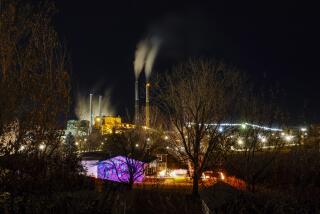Proposed industrial route through scenic Idaho raises alarm
Reporting from Kooskia, Idaho — Most states have places — wide prairies, snow-capped peaks, autumn-hued ridges — the locals like to refer to as “God’s country.” People know you don’t get to the real stuff, though, until you hit Idaho.
Here on U.S. 12, where a two-lane finger of asphalt winds its lonely way along the Clearwater River through rocky slopes of cedar, fir and ponderosa pine, it’s more than just a turn of phrase: A quiet meadow along the river is where, Nez Perce Indian legend has it, a coyote cut out the heart of a plundering monster and, with its death, gave birth to human civilization. Nearby, where the river gurgles through wheat-colored hills, is where Meriwether Lewis and William Clark ended their epic land trek and built canoes for their final push to the sea.
“This is the last of the big wild. You can go 100 miles north and cross one dirt road and one gravel road…. There aren’t too many places like that,” said Linwood Laughy, a tour guide and publisher of local travel books, who has lived most of his life in this remote border country between Idaho and Montana, high in the northern Rockies.
But U.S. 12 is suddenly being targeted as a heavy-duty commercial route for shipments of giant oil-field equipment, prompting some locals to go to court against big energy companies and the state to protect one of the West’s premier hunting and fishing destinations.
As a major new oil development gets underway 1,100 miles north in the tar sands of Alberta, Canada, a venture connected to Exxon Mobil, Imperial Oil, has told the Idaho and Montana departments of transportation that it hopes to send 207 oversize shipments of petroleum equipment — some 210 feet long, 24 feet wide and 30 feet high — up the remote highway, through Montana and into Canada.
In another proposal, ConocoPhillips has a separate application to ship four huge oil drums up Highway 12 along a similar route to Billings, Mont. A lawsuit to overturn the permits will be heard by the Idaho Supreme Court on Oct. 1.
Officials at the Port of Lewiston, Idaho — 465 miles up the Columbia and Snake rivers from the coast, between Washington and Idaho, where the trucking route would originate — say these could be the first in a potential new wave of extra-large shipments traveling up the highway, including oil-field equipment for Alberta and wind turbines for the Midwest.
“Logistics firms have discovered that Highway 12 is the only route on the West Coast on which you can get oversize cargoes into the interior of the U.S. where there are no height restrictions due to [overhead] structures,” said David Doeringsfeld, port manager.
The proposals have generated alarm among many in the backcountry of Idaho and Montana, where the route runs not only along the middle fork of the Clearwater and Lochsa rivers — both designated for protection under the original federal Wild and Scenic Rivers Act — but also the Blackfoot River in Montana, scene of Norman Maclean’s much-loved book “A River Runs Through It.”
“We’re transforming a wild and scenic byway into a major industrial corridor without even telling anybody,” said Laird Lucas, executive director of Advocates for the West, which is representing Laughy and other residents along the river corridor in their suit against ConocoPhillips.
Idaho officials said extra-wide shipments are nothing new on Highway 12; 245 have been permitted over the last decade. But proposed oil-field shipments are larger and heavier, some weighing up to 675,500 pounds, more than eight times the normal truck weight limit on interstate highways.
Because the travel portion of the road is only 24 feet wide, traffic will have to be stopped to make way for each shipment. Transport will be restricted to late-night hours and accompanied by safety crews to control traffic and limit road closures to 10 to 15 minutes.
The modules will be transported on trailers outfitted with extra safety equipment — up to 14 axles and 114 tires, with separate steering and braking systems on each axle, Imperial spokesman Pius Rolheiser said.
Rolheiser said the company settled on Highway 12 as one of the only viable options for getting the equipment to its destination; a route through British Columbia, Canada, ran into tunnels and narrow bridges, and shipping up interstate highways from the southern U.S. would require expensive reconfiguration of a number of overpasses.
But opponents worry that the oil industry has simply found a cheap new way to open up Canada’s oil sands at the expense of one of America’s national treasures.
“Your help is needed to send a strong message that the Lochsa River and Highway 12 can’t be sacrificed for greater oil company profits,” the conservation group Idaho Rivers United said in a message to its supporters over the summer. The City Council in Missoula, Mont., has also voiced opposition.
And the Nez Perce tribe, which has gone to great efforts to restore salmon runs on the Clearwater and nearby rivers, has complained that it was never consulted about a route that goes through the heart of its reservation.
“Coming into our reservation, our home, and not even talking to an indigenous tribe?” said Brooklyn Baptiste, tribal vice president. “We’re afraid it’ll turn into some major port of entry for those types of loads.”
Montana has required a full environmental assessment before it issues any permits. Idaho has no similar requirement, but the state’s decision in August to approve ConocoPhillips’ permits was reversed by Idaho District Judge John Bradbury, leading to the current expedited appeal before the state Supreme Court.
Laughy and his wife, Borg Hendrickson, say the transports could impair the region’s crucial tourism economy, and worry that the road closures could endanger residents who may need to get quickly to a hospital or call a firetruck.
Others in northern Idaho say the nighttime shipments will not be disruptive. Even better, they could bring jobs to the region.
“There are a very small minority of people in north central Idaho who are opposed to this project,” said Doeringsfeld of the Port of Lewiston. “I think most people understand the potential job creation benefits that this project will bring.”
kim.murphy@latimes.com
More to Read
Sign up for The Wild
We’ll help you find the best places to hike, bike and run, as well as the perfect silent spots for meditation and yoga.
You may occasionally receive promotional content from the Los Angeles Times.






